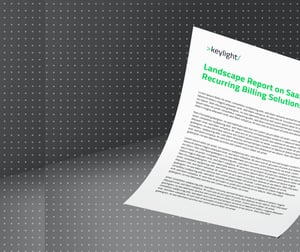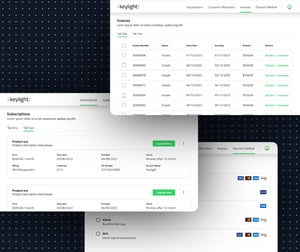Subscription billing and financial goals
Exploring the operational foundation for subscription billing
We have written about how transitioning to a subscription business is about more than individual components, but a cross-organizational exercise in both functionality and mindset. Meeting those needs however does have some core financial capabilities that are highly technical and have to deliver to particularly important and complex needs in order to drive commercial success.
In our most recent article we wrote about subscription billing and what subscription billing systems do. Here we wanted to delve a little deeper into how the mechanics of those systems separate them from regular billing models and not only enable recurring billing and payments, but track four essential areas of financial health for commercial success and peace of mind.
These areas are:
- Customer journeys and pricing
- Tax compliance
- Revenue recognition
- Analytics and forecasting
A truly successful subscription-based billing model takes a much more holistic approach to the customer journey and end-to-end business processes.
How subscription-based billing models optimize customer journeys and pricing
Personalized options at different stages of the customer journey
Subscription business success is directly linked to the customer journey and the customer experience, which in turn is enormously impacted by pricing. That is less to do with the price itself, and more to do with the sense of value as well as how pricing is communicated, both at the outset and when it comes to price increases.
Dedicated subscription-based billing models give you options for variable and personalized approaches to pricing, upgrades and the rollout of price changes. In theory, you can charge a customer a fixed amount every month and call it a subscription, but true subscription pricing options can be much more diverse. This is important for understanding the market and supporting customer retention.
For example, with the right system you can shape and evolve pricing to impact the customer journey. You might bill the customer monthly but lock them into an annual term, charge an early cancellation fee or reward them with a 10% discount if they upgrade within the first three months. You could also consider adding usage-based metrics to bill on top of the monthly recurring fee. Achieving that requires a robust billing engine that connects with the different customer journeys and bills the way that fits your business needs.
How subscription-based billing models ensure tax compliance
Ensuring compliance across territories
Staying on top of tax compliance is one of those things that can keep subscription business owners awake at night, especially if you trade across different territories. Recurring income also has the capacity to result in risk, especially when it comes to sales tax compliance.
As you grow, it can become difficult to stay on top of the volume of state and municipal sales tax laws, regulations and rates, particularly with the continual pace of change in that sphere. For example, there are 11,000 tax jurisdictions in the US and they collectively made 592 standard sales tax rate changes in 2020 alone.
If you have a successful subscription business, then you need a system that dependably and accurately automates tax compliance according to different regions. It needs to combine the billing and shipping address, calculate the sales tax, and automatically book it to the right accounting code.
It sounds fairly straightforward, but spread across hundreds or thousands of transactions and changing regulations everyday, a manual approach can quickly get out of control. The connectivity within a dedicated subscription-based billing model accommodates and stays on top of all those complexities seamlessly, calculating the correct sales taxes for invoices with a well-integrated tax engine.
How subscription-based billing models support revenue recognition
Addressing accounting requirements
Typically, revenue is recognized at the moment it's earned but in subscription services it's recognized over time. This is because payment is often required upfront and is received before services have been delivered. However, revenue cannot be fully recognized and distributed across the business until the service has been delivered over a designated period of time.
This delay means more complex accounting requirements in order to maintain accurate records, both in real time and in the end of year accounts. For example, when a customer requests a change to a subscription product, the already distributed revenue may need to be recalculated. That's before you begin to address the accounting complexity of bundled products.
A subscription-based billing model needs to be designed with this principle in mind, understanding that it's the baseline for subscription finances rather than a unique circumstance. It does this by using revenue recognition rules. Otherwise, businesses will constantly be chasing their tails or making commercial decisions based on inaccurate financial information.
How subscription-based billing models optimize analytics
Understanding customers better
Successful subscription businesses are all about knowing and understanding the customer; not only meeting their current needs but predicting their upcoming ones as well. That makes analytics even more important in subscriptions than any other business model, because they not only impact future sales but existing customer retention, which is the lifeblood of subscription organizations.
Subscription businesses are also in a uniquely strong position to understand customers because of the ongoing nature of their relationships. However, the platform in which they operate is instrumental to achieving that. You need a clear and ongoing view of how customers interact with products, upgrades, downgrades and new product purchases in order to observe the right metrics and future-proof your business by turning them into meaningful actions.
This requires structured data that provides the information itself as well as the context for that information. Without the right system, over time the volume of information can become challenging to contend with as the number of customers, vendors and customizations grow. In a subscription business system like keylight, those needs are met through an end-to-end and natively unified user experience, automation and predictive analytics, removing traditional roadblocks and maximizing commercial opportunities.
About keylight
A business platform that supports your vision
keylight is unique in the subscription platform market because all these considerations and more have been considered from the start. The platform’s development from the outset has been focused on delivering an end-to-end approach and configurability for businesses, not only to meet demands today but to keep up with the speed of change as organizations, customers, the market and technology evolve.
We know that a visionary business cannot be built without a strong foundation of platform fundamentals. Therefore, keylight is a deeply practical system that’s about enabling businesses to achieve the kind of financial health that leaders can trust in, leaving headspace, time and resources to focus on the unique and game-changing ideas that set your business apart without limits and without distraction.

Power your business
with the right subscription solutions
![]() Book a free consultation
Book a free consultation
Power your business
with the right subscription solutions
![]() Book a free consultation
Book a free consultation

Explore keylight's superior value compared to conventional subscription platforms
![]() Compare now
Compare now
Explore keylight's superior value compared to conventional subscription platforms
![]() Compare now
Compare now




